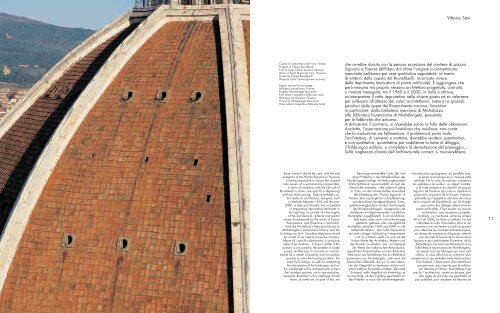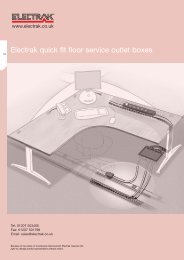by Stone & Sannini - EKA Group
by Stone & Sannini - EKA Group
by Stone & Sannini - EKA Group
You also want an ePaper? Increase the reach of your titles
YUMPU automatically turns print PDFs into web optimized ePapers that Google loves.
Cupola di Santa Maria del Fiore, Firenze.<br />
Progetto di Filippo Brunelleschi.<br />
Foto di Carlo Cantini (archivio <strong>Sannini</strong>).<br />
Dome of Santa Maria del Fiore, Florence.<br />
Project <strong>by</strong> Filippo Brunelleschi.<br />
Photo <strong>by</strong> Carlo Cantini (<strong>Sannini</strong> archive).<br />
Pagina successiva/next page:<br />
Biblioteca Laurenziana, Firenze.<br />
Progetto Michelangelo Buonarroti.<br />
Foto Istituto Fotografico Editoriale Scala.<br />
Biblioteca Laurenziana, Florence.<br />
Project <strong>by</strong> Michelangelo Buonarroti.<br />
Photo Istituto Fotografico Editoriale Scala.<br />
those where it should be used: with the sad<br />
exception of the Piazza Signoria in Florence<br />
(it being impossible to restore the original<br />
cotto pavers of a workmanship comparable,<br />
in terms of rendition, with the tile roof of<br />
Brunelleschi’s dome, one opts for a depressing<br />
artificial stone paving). And nevertheless no,<br />
but really no architecture, designed, built<br />
or shelved, between 1960 and the year<br />
2000, in Italy and abroad, has succeeded<br />
in interpreting Imprunetino terracotta in<br />
the right key, or carried it to the heights<br />
of the architectural, material and spatial<br />
values characterised <strong>by</strong> the works of Tuscan<br />
Renaissance, and Florentine in particular,<br />
from the Michelozzi’s Marciana Library to<br />
Michelangelo’s Laurenziana Library, and the<br />
buildings we love. Countless objections would<br />
be raised if one tried to prove the contrary.<br />
Above all - and this observation is annoying<br />
rather than insidious - it doesn’t matter if the<br />
solution is unsuccessful, the problem is badly<br />
posed, architecture, in concrete or in brick,<br />
should be a matter of quantity and not quality,<br />
quantity to solve the housing problem, the<br />
need for buildings, as well as completing<br />
the devastation of the landscape: and on<br />
the wavelength of the architecturally correct<br />
the countless positive, not to say seductive,<br />
examples illustrated in this catalogue should<br />
move, or rather stir. In spite of this, we<br />
che avrebbe dovuto con la penosa eccezione del cantiere di piazza<br />
Signoria a Firenze (diffidato dal rifare l’originario ammattonato,<br />
manufatto bellissimo per resa qualitativa appaiabile al manto<br />
di embrici della cupola del Brunelleschi; incaricato invece<br />
della deprimente lastricatura di pietra artificiale). E aggiungere che<br />
però nessuna ma proprio nessuna architettura progettata, costruita,<br />
o rimasta ineseguita, tra il 1960 e il 2000, in Italia o altrove,<br />
sa interpretare il cotto imprunetino nella chiave giusta né sa valersene<br />
per sollevarsi all’altezza dei valori architettonici, materici e spaziali,<br />
peculiari delle opere del Rinascimento toscano, fiorentino<br />
in particolare, dalla biblioteca marciana di Michelozzo<br />
alla biblioteca laurenziana di Michelangelo, passando<br />
per le fabbriche che amiamo.<br />
A dimostrare il contrario, si alzerebbe subito la folla delle obbiezioni.<br />
Anzitutto, l’osservazione più fastidiosa che insidiosa: non conta<br />
che la risoluzione sia fallimentare, il problema è posto male,<br />
l’architettura, di cemento o mattone, dovrebbe rendersi quantitativa,<br />
e non qualitativa, quantitativa per soddisfare la fame di alloggio,<br />
il fabbisogno edilizio, e completare la devastazione del paesaggio…<br />
Sulla lunghezza d’onda dell’architecturally correct, si muoverebbero,<br />
bevorzugt verwendete Cotto, der sich<br />
ohne Probleme in den Wiederaufbau der<br />
Nachkriegszeit einfügt, mit dem sogenannten<br />
Wirtschaftsboom zusammenfällt. Im Lauf der<br />
Geschichte entstehen viele andere Projekte<br />
in Cotto, mit der schmerzhaften Ausnahme<br />
der Entseelung der “Piazza Signoria“ in<br />
Florenz (die ursprüngliche Cottopflasterung,<br />
wunderschöner handgeschlagener Cotto,<br />
qualitativ vergleichbar mit den Dachziegeln<br />
der Brunelleschikuppel, rausgerissen und<br />
stattdessen mit deprimierenden, künstlichen<br />
Steinplatten zugepflastert). Es ist anzuführen,<br />
daß keine, aber auch nicht eine einzige<br />
geplante, gebaute oder unausgeführte<br />
Architektur zwischen 1960 und 2000 in und<br />
außerhalb Italiens, den Cotto Imprunetino<br />
mit dem richtigen Schlüssel zu interpretieren<br />
und zu schätzen weiß, um sich auf die<br />
hohen Werte der Architektur, Materie und<br />
des Raumes zu erheben, wie zum Beispiel<br />
die Werke der toskanischen Renaissance,<br />
speziell der florentinischen von der Biblioteca<br />
Marciana von Michelozzo bis zur Biblioteca<br />
Laurenziana von Michelangelo, oder auch die<br />
historischen Gebäude, die wir so sehr lieben.<br />
Um das Gegenteil zu beweisen würden sich<br />
sofort zahllose Einwände erheben. Der erste<br />
Einwand, mehr ärgerlich als hinterlistig: es<br />
ist unwichtig, ob das Ergebnis gescheitert ist,<br />
das Problem ist noch viel schwerwiegender:<br />
Vittorio Savi<br />
reconstruction après-guerre, en parallèle avec<br />
le boom économique qui a marqué cette<br />
période. Par la suite, le matériau contamine<br />
les opérateurs du secteur -au départ hostiles-<br />
à la triste exception du chantier de piazza<br />
Signoria de Florence (qui s’est vu interdire la<br />
production originaire de la brique, matériau<br />
splendide qui rappelle le manteau de noues<br />
de la coupole de Brunelleschi; qui fut chargé<br />
par contre des dallages déprimants en<br />
pierre artificielle). Il faut ajouter qu’aucune<br />
architecture, sans exception, projetée,<br />
construite, ou inachevée, entre les années<br />
60 et l’an 2000, en Italie ou ailleurs, ne sait<br />
interpréter le cotto imprunetino dans la clé<br />
correcte ni ne sait mettre à profit ce produit<br />
pour atteindre les sommets architectoniques,<br />
en termes de matières et d’espaces, atteints<br />
par les chefs-d’oeuvre de la renaissance<br />
Toscane et plus précisément Florentine, de la<br />
bibliothèque marciana de Michelozzo à la<br />
bibliothèque laurenziana de Michelangelo,<br />
en passant par les fabriques qui nous sont<br />
chères. Si nous affirmions le contraire nous<br />
assisterions à une véritable levée de boucliers.<br />
Tout d’abord, l’observation plus fastidieuse<br />
que perverse: peu importe que la solution<br />
soit destinée à l’échec, le problème n’est<br />
pas là, l’architecture, ciment ou briques, doit<br />
être jugée du point de vue quantitatif, et<br />
pas qualitatif, pour satisfaire les besoins de<br />
11





